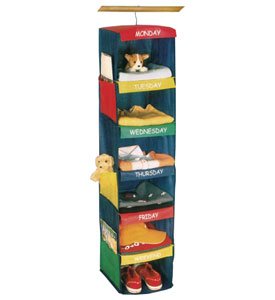Her guest post is the final installment of our Preserving Treasures series on the That’s Neat! Blog. Read the first posts, Preserving Paper and Preserving Photos.
It’s the time of year for momentous events: First Holy Communion, prom, weddings. You could say it is also your dry cleaner's favorite time of the year as hundreds of dresses pass through their shops.
But before you follow the old advice of having your special garment sealed in a box for posterity, there are a few things to know in order for your dress (or suit) to last a few decades. I'll go through the don'ts first so that you avoid making mistakes that will actually shorten the lifespan of your garment.
Do Not:
- Leave your garment in a plastic bag unclean for months or years.
- Have your dress/suit vacuum sealed in a box after it has been dry cleaned.
- Store your garment in a cedar chest or closet or pack it in moth balls.
What? Aren't these the tried and true ways of preserving garments? Yes, these are tried methods but they have been found to be not true.
Garments stored in vacuum sealed boxes after dry cleaning have been found, once opened, to have yellowed, permanently creased, and become brittle. Why? The off gassing of the dry cleaning chemicals, the lack of oxygen, and the stationary storage of the garment all lead to deterioration of the garment. Garments stored in cedar chests/closets or moth balls end up breaking down due to the acids in the cedar and the off gassing from the moth balls.
The main culprits that shorten the lifespan of your garments are:
- Light
- Temperature/Humidity
- Dust/dirt
- Acidic environment
- Lack of oxygen
The best way to think about how you want to store your garments is to think about the environment most of us like: not direct sunlight, ambient temperatures that do not fluctuate, low humidity, and a clean environment, with plenty of oxygen. This is what your garments need to survive long term storage.
What you should do:
- Have your garment dry cleaned. Try to get it cleaned within a few weeks of wearing it, especially if there is a stain or a drink (even clear liquids) spilled/dried on it.
- As soon as you bring the garment home, remove it from the plastic bag and the wire hanger.
- Decide how you want to store it: Hanging up or folded in a box (See below).
- Schedule a date with your garment 6 months from now. If you hung the garment, take it out and make sure that it is doing okay. Check for mold, moth holes, or stains. Make sure the shoulder seams are holding up and are not molded to the hanger. If you have to, replace the padded hanger. Once everything checks out, put the garment back in the closet and make another date for 6 months from now. The same routine will happen for your boxed garments except that you will need to refold the garment in a different direction so as to reduce the wear and tear the original folds experienced in the first 6 months of storage.
To hang:
Make sure you hang the garment on a padded hanger; unbleached muslin is preferred so dye is not transferred.
Use the twill tape loops that were included as part of the garment to hang it on the hanger. These loops help distribute the weight of the garment and alleviate the strain on the shoulder seam stitches.
Store the garment in a cotton bag like this one from The Container Store.
Put this bag in a bedroom closet that is kept in a room that is kept at an even temperature.
To box up:
Purchase an Acid-free, buffered* card board box along with acid free tissue paper. You can usually buy kits that sell these items together. *Note that if you are storing wools, silks, leather, fur, & feathers, you need to purchase an un-buffered box.
Working on a flat surface with no jewelry and clean hands, lay out your garment. For each fold you want to make in the garment, create a roll of tissue paper to act as a cushion to put in-between each fold. This is going to help prevent hard creases in your garment and reduce the strain on the fabric.
Once you have finished folding the garment to the box size, put it in the box but do not tape it shut. Put the box in a bedroom closet that is kept at an even temperature.
If you have the desire to store your hanging or boxed garment in a basement or attic, STOP! If this is a sentimental garment that has value, you should be willing to store it in the appropriate space. You don't tend to store valuable jewelry in the basement or attic and you shouldn't store your sentimentally valuable garments there either.
Follow the directions above and you will have a garment to proudly show off and lend to children and grandchildren.




 More Travel Tips coming in from
More Travel Tips coming in from 

















